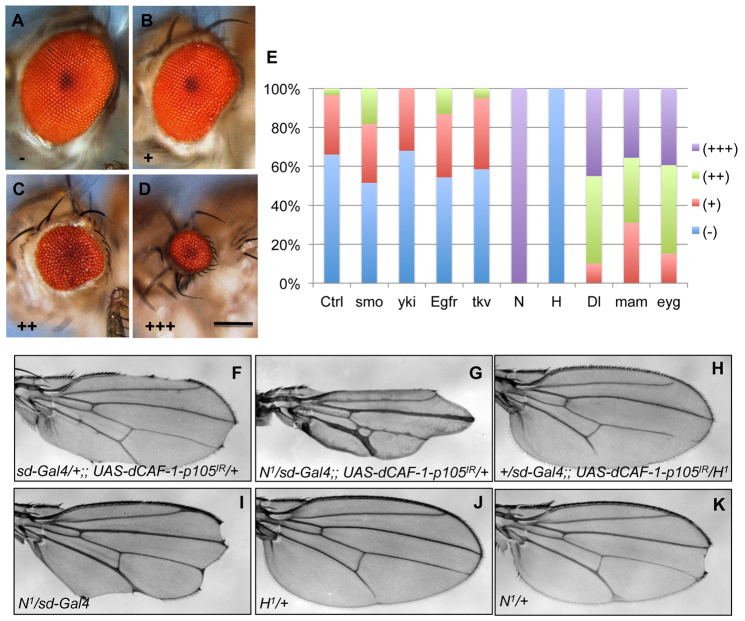Fig. 1.
dCAF-1-p105 genetically interacts with the Notch pathway in the eye and wing. (A-E) Genetic interaction of dCAF-1-p105 and the Notch pathway in the eye. Eyes of wild-type adult flies (A) and flies that express dCAF-1-p105IR in a wild-type (B,C) or heterozygous N1 background (D) are classified into four classes according to eye size (E). Scale bar: 200 μm. (E) The penetrance and expressivity of small-eye phenotypes for flies of the different genotypes. Ctrl represents ey>dCAF-1-p105IR. smo, yki, Egfr, tkv, N, H, Dl, mam and eyg represent flies of ey>dCAF-1-p105IR in the background of one copy of the mutation for each indicated gene. (F-K) Genetic interaction of dCAF-1-p105 and the Notch pathway in the wing. (F) dCAF-1-p105 knockdown under the control of sd-Gal4 causes loss of wing margins (100%, n=50). (G) The loss of wing margin phenotype of sd>dCAF-1-p105IR is enhanced in the presence of one copy of N1 (100%, n=50; removing nearly all of the wing margin). (H) The loss of wing margin phenotype of sd>dCAF-1-p105IR is suppressed by a copy of the H1 mutation (66.1%, n=62). (J) H1/+ shows a mild Notch gain-of-function phenotype with an interruption of longitudinal vein 5 (LV5) in the distal part (100%, n=50). (I,K) Note that the notched wings of N1/+ can apparently also be enhanced in combination with sd-Gal4 (greater loss of wing margins), but is further enhanced when dCAF-1-p105IR is introduced (G). For I, the penetrance is 100%, referring to a phenotype that, on average, removes nearly 50% of the total wing margin (n=50), and for K the penetrance is 11.8%, referring to a weak phenotype that usually exhibits a single distal notch of the wing (N=110; supplementary material Fig. S1B).

